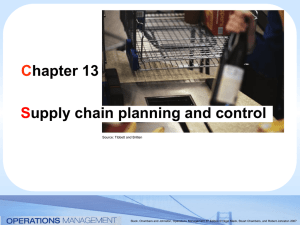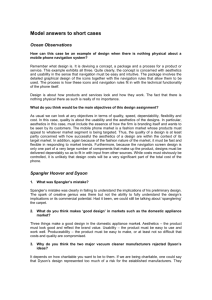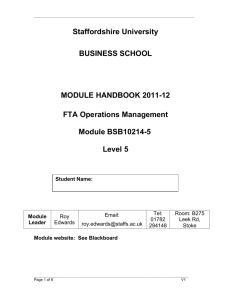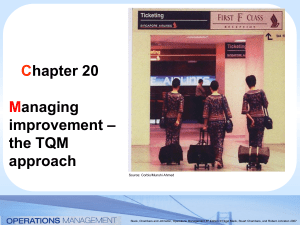revision slides
advertisement
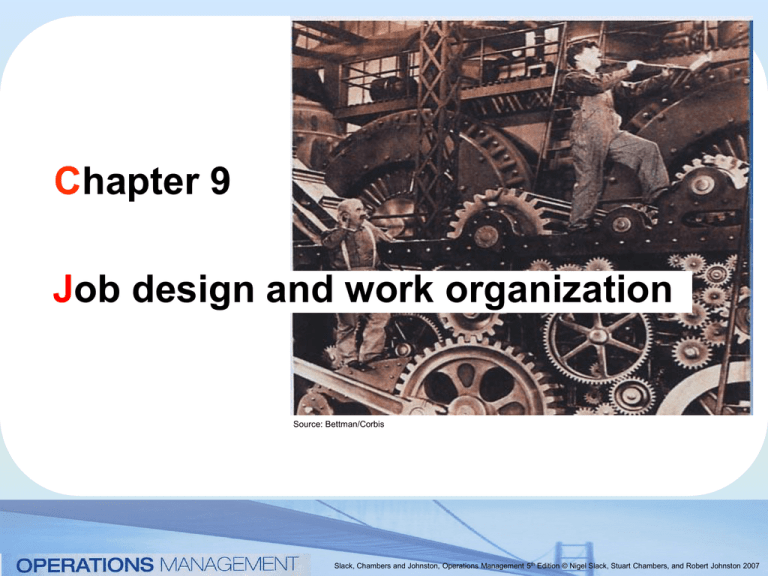
Chapter 9 Job design and work organization Source: Bettman/Corbis Slack, Chambers and Johnston, Operations Management 5th Edition © Nigel Slack, Stuart Chambers, and Robert Johnston 2007 Key Terms Test Job design The way in which we structure the content and environment of the jobs of individual staff members within the workplace and the interface with the technology or facilities that they use. Ergonomics A branch of job design that is primarily concerned with the physiological aspects of job design, with how the human body fits with process facilities and the environment; can also be referred to as human factors, or human factors engineering. Human factors engineering An alternative term for ergonomics. Slack, Chambers and Johnston, Operations Management 5th Edition © Nigel Slack, Stuart Chambers, and Robert Johnston 2007 Key Terms Test Repetitive strain injury (RSI) Damage to the body because of repetition of activities. Anthropometric data Data that relates to people’s size, shape and other physical abilities, used in the design of jobs and physical facilities. Division of labour An approach to job design that involves dividing a task into relatively small parts, each of which is accomplished by a single person. Slack, Chambers and Johnston, Operations Management 5th Edition © Nigel Slack, Stuart Chambers, and Robert Johnston 2007 Key Terms Test Scientific management A school of management theory dating from the early twentieth century; more analytical and systematic than ‘scientific’ as such, sometimes referred to (pejoratively) as Taylorism, after Frederick Taylor who was influential in founding its principles. Method study The analytical study of methods of doing jobs with the aim of finding the ‘best’ or an improved job method. Work measurement A branch of work study that is concerned with measuring the time that should be taken for performing jobs. Slack, Chambers and Johnston, Operations Management 5th Edition © Nigel Slack, Stuart Chambers, and Robert Johnston 2007 Key Terms Test Work study The term generally used to encompass method study and work measurement, derived from the scientific management school. Principles of motion economy A checklist used to develop new methods in work study that is intended to eliminate elements of the job, combine elements together, simplify the activity or change the sequence of events so as to improve efficiency. Qualified worker The term used in work study to denote a person who is accepted as having the necessary physical attributes, intelligence, skill, education and knowledge to perform the task. Slack, Chambers and Johnston, Operations Management 5th Edition © Nigel Slack, Stuart Chambers, and Robert Johnston 2007 Key Terms Test Standard performance The term used in work measurement to indicate the rate of output that qualified workers will achieve without over-exertion as an average over the working day, provided they are motivated to apply themselves, now generally accepted as a very vague concept. Basic time The time taken to do a job without any extra allowances for recovery. Time study A term used in work measurement to indicate the process of timing (usually with a stopwatch) and rating jobs. It involves observing times, adjusting or normalizing each observed time (rating) and averaging the adjusted times. Slack, Chambers and Johnston, Operations Management 5th Edition © Nigel Slack, Stuart Chambers, and Robert Johnston 2007 Key Terms Test Rating A work study technique that attempts to assess a worker’s rate of working relative to the observer’s concept of standard performance. It is controversial and now accepted as being an ambiguous process. Standard time A term used in work measurement that indicates the total time taken to do a job, including allowances for recovery and relaxation. Allowances The term used in work study to indicate the extra time allowed for rest, relaxation and personal needs. Slack, Chambers and Johnston, Operations Management 5th Edition © Nigel Slack, Stuart Chambers, and Robert Johnston 2007 Key Terms Test Synthesis from elemental data A work measurement technique for building up a time from previously timed elements. Predetermined motion–time systems (PMTS) A work measurement technique in which standard elemental times obtained from published tables are used to construct a time estimate for a whole job. Job rotation The practice of encouraging the movement of individuals between different aspects of a job in order to increase motivation. Slack, Chambers and Johnston, Operations Management 5th Edition © Nigel Slack, Stuart Chambers, and Robert Johnston 2007 Key Terms Test Job enlargement A term used in job design to indicate increasing the amount of work given to individuals in order to make the job less monotonous. Job enrichment A term used in job design to indicate increasing the variety and number of tasks within an individual’s job. This may include increased decision making and autonomy. Empowerment A term used in job design to indicate increasing the authority given to people to make decisions within the job or changes to the job itself. Slack, Chambers and Johnston, Operations Management 5th Edition © Nigel Slack, Stuart Chambers, and Robert Johnston 2007 Key Terms Test Multi-skilling Increasing the range of skills of individuals in order to increase motivation and/or improve flexibility. Flexi-time working Increasing the possibility of individuals varying the times during which they work. Annual hours A type of flexi-time working that controls the amount of time worked by individuals on an annual rather than a shorter basis. Teleworking The ability to work from home using telecommunications and/or computer technology. Slack, Chambers and Johnston, Operations Management 5th Edition © Nigel Slack, Stuart Chambers, and Robert Johnston 2007
